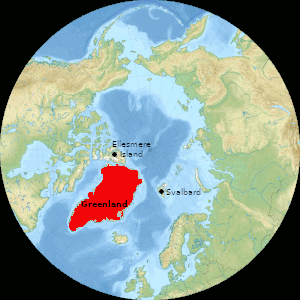
Circle the area on this map

C. Greenland is an autonomous country of the Kingdom of Denmark in Europe, but it is geographically part of the North American continent. After being tracked by satellite on its journey to Ellesmere Island in the Canadian Arctic Archipelago, the fox’s radio collar stopped transmitting.
D. Greenland is the world’s largest island - Australia and Antarctica are larger but considered continents. It is covered by the only permanent ice sheet outside Antarctica. With only 55,877 people living on its 836,297 square miles, Greenland is the least densely populated nation or dependent territory in the world
B. Norway’s Svalbard Global Seed Vault houses more than 400,000 frozen seed samples from around the world. The seeds are stored in an abandoned coal mine on island of Spitsbergen. In October 2016, the seed vault experienced an unusually large water intrusion because of higher temperatures and heavy rainfall. The water froze before reaching the seeds.
A. The oceans would rise about 7 meters, or 23 feet, according to NASA scientists. Nobody expects all the ice to melt in the next few centuries, but “the rate at which Greenland is dumping ice and water into the ocean is not just surprisingly high, it keeps getting higher,” said one NASA scientist.